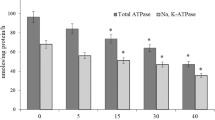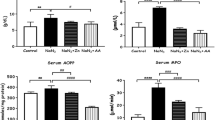Abstract
Potassium dichromate (K2Cr2O7) is a soluble hexavalent chromium compound that is widely used in several industries. In the present work the effect of administration of K2Cr2O7 on rat intestinal brush border membrane (BBM) enzymes and anti-oxidant system was studied. Rats were given a single oral dose of K2Cr2O7 (100 mg/kg body weight) and sacrificed 6, 12, 24, 48 and 96 h after the treatment. Control animals were not given K2Cr2O7. The administration of K2Cr2O7 resulted in a reversible decline in the specific activities of several BBM enzymes. The decrease in the activities of these enzymes was due to changes in the maximum velocity while their affinities for the substrates remained unchanged. Lipid peroxidation increased while total SH groups decreased in K2Cr2O7-treated rats as compared to controls indicating increased oxidative stress in the intestinal mucosa. The activities of superoxide dismutase and glutathione-S-transferase increased while those of catalase, glutathione reductase, thioredoxin reductase and glucose-6-phosphate dehydrogenase decreased. The maximum changes in all the parameters studied above were 24 h after administration of K2Cr2O7 after which recovery took place, in most cases almost to control values after 96 h. These results show that oral administration of K2Cr2O7 to decrease in the activities of BBM enzymes, increase in oxidative stress and alters the activities of anti-oxidant enzymes in rat intestine.

Similar content being viewed by others
References
Aebi H (1984) Catalase in vitro. Methods Enzymol 105:121–126
Arner ESJ, Holmgren A (2000) Physiological functions of thioredoxin and thioredoxin reductase. Eur J Biochem 267:6102–6109
Bagchi D, Bagchi M, Stohs SJ (2001) Chromium (VI) induced oxidative stress, apoptotic cell death and modulation of p53 tumor suppressor gene. Mol Cell Biochem 222:149–158
Bagchi D, Stohs SJ, Downs BW, Bagchi M, Preuss HG (2002) Cytotoxicity and oxidative mechanisms of different forms of chromium. Toxicology 180:5–22
Bataineh H, al-Hamood MH, Elbetieha A, Bani Hani I (1997) Effect of long-term ingestion of chromium compounds on aggression, sex behavior and fertility in adult male rat. Drug Chem Toxicol 20:133–149
Boge G, N’Diaye P, Roche H, Peres G (1989) Effects of hexavalent chromium at non-lethal concentrations on the enzymology of the intestine of Salmo gairdneri and Dicentrarchus labrax (Pisces). J Physiol (Paris) 83:57–63
Buege JA, Aust SD (1978) Microsomal lipid peroxidation. Methods Enzymol 52:302–308
Carlberg I, Mannervik B (1985) Glutathione reductase. Methods Enzymol 113:484–490
Donaldson RM Jr, Barreras RF (1966) Intestinal absorption of trace quantities of chromium. J Lab Clin Med 68:484–493
Farooq N, Yusufi ANK, Mahmood R (2004) Effect of fasting on enzymes of carbohydrate metabolism and brush border membrane in rat intestine. Nutr Res 24:407–416
Fatima S, Arivarasu NA, Banday AA, Yusufi ANK, Mahmood R (2005) Effect of potassium dichromate on renal brush border membrane enzymes and phosphate transport in rats. Hum Exp Toxicol 24:631–638
Fernandes MA, Geraldes CF, Oliveira CR, Alpoim MC (2000) Chromate-induced human erythrocytes haemoglobin oxidation and peroxidation: influence of vitamin E, vitamin C, salicylate, deferoxamine, and N-ethylmaleimide. Toxicol Lett 114:237–243
Forman HJ, Boveris A (1982) Superoxide radical and hydrogen peroxide in mitochondria. In: Pryor WA (ed) Free radicals in biology. Academic Press, New York, pp 65–90
Glossmann H, Neville DM (1972) γ-Glutamyl transferase in kidney brush border membranes. FEBS Lett 19:340–344
Goldmann DR, Schlesinger H, Segal S (1976) Isolation and characterization of the brush border fraction from newborn rat renal proximal tubule cells. Biochim Biophys Acta 419:251–260
Goldstein A, Lampen JO (1975) Beta-d-fructofuranoside fructohydrolase from yeast. Methods Enzymol 42:504–511
Gumbleton M, Nicholls PJ (1988) Dose-response and time-response biochemical and histological study of potassium dichromate-induced nephrotoxicity in the rat. Food Chem Toxicol 26:37–44
Habig WH, Pabst MJ, Jokoby WB (1974) Glutathione S-transferases. The first enzymatic step in mercapturic acid formation. J Biol Chem 249:130–7139
Harris GK, Shi X (2003) Signaling by carcinogenic metals and metal-induced reactive oxygen species. Mutat Res 533:183–200
Jennette KW (1981) The role of metals in carcinogenesis: biochemistry and metabolism. Environ Health Perspect 40:233–252
Katz SA, Salem H (1993) The toxicology of chromium with respect to its chemical speciation: a review. J Appl Toxicol 13:217–224
Kerger BD, Paustenbach DJ, Corbett GE, Finley BL (1996) Absorption and elimination of trivalent and hexavalent chromium in humans following ingestion of a bolus dose in drinking water. Toxicol Appl Pharmacol 141:145–158
Kirschbaum BB, Sprinkel FM, Oken DE (1981) Proximal tubule brush border alterations during the course of chromate nephropathy. Toxicol Appl Pharmacol 58:19–30
Liu KJ, Shi X (2001) In vivo reduction of chromium (VI) and its related free radical generation. Mol Cell Biochem 222:41–47
Lowry OH, Rosebrough NJ, Farr AL, Randall RJ (1951) Protein measurement with Folin phenol reagent. J Biol Chem 193:265–275
Lu YY, Yang JL (1995) Long term exposure to chromium(VI) oxide leads to defects in sulfate transport system in Chinese hamster ovary cells. J Cell Biochem 57:655–665
Mackenzie RD, Anwar RA, Byerrum RU, Hoppert CA (1959) Absorption and distribution of 51Cr in the albino rat. Arch Biochem Biophys 79:200–205
Marklund S, Marklund G (1974) Involvement of the superoxide anion radical in the autooxidation of pyrogallol and a convenient assay for superoxide dismutase. Eur J Biochem 47:469–474
McNeil LK, Hamilton JR (1971) The effect of fasting on disaccharidase activity in the rat small intestine. Pediatrics 47:65–72
Mertz W (1969) Chromium occurrence and function in biological systems. Physiol Rev 49:163–239
Pellerin C, Booker SM (2000) Reflections on hexavalent chromium: health hazards of an industrial heavyweight. Environ Health Perspect 108:A402–A407
Scherberich JE, Wolf G, Schoeppe W (1993) Shedding and repair of renal cell membranes following drug-induced nephrotoxicity in humans. Eur J Clin Pharmacol 44:S33–S38
Sedlak J, Lindsay RH (1968) Estimation of total, protein-bound and nonprotein sulphydryl groups in tissue with Ellman’s reagent. Anal Biochem 25:192–205
Sengupta T, Chattopadhyay D, Ghosh N, Das M, Chatterjee GC (1990) Effect of chromium administration on glutathione cycle of rat intestinal epithelial cells. Indian J Exp Biol 28:1132–1135
Shi XG, Chiu A, Chen CT, Halliwell B, Castranova V, Vallyathan V (1999) Reduction of chromium (VI) and its relationship to carcinogenesis. J Toxicol Environ Health 2:87–104
Shonk CC, Boxer GE (1964) Enzyme patterns in human tissues. I. Methods for the determination of glycolytic enzymes. Cancer Res 24:709–721
Solis-Heredia MJ, Quintanilla-Vega B, Sierra-Santoyo A, Hernandez JM, Brambila E, Cebrian ME, Albores A (2000) Chromium increases pancreatic metallothionein in the rat. Toxicology 142:111–117
Standevan AM, Wetterhahn KE (1991) Ascorbate is the principal reductant of chromium(VI) in rat liver and kidney ultrafiltrates. Carcinogenesis 12:1733–1739
Sterekhova NP, Zeleveva NI, Solomina SN, Tiushniakova NV, Miasnikova AG (1978) Stomach pathology in workers in chromium salt manufacture. Gig Tr Prof Zabol (Russian) 3:19–23
Stohs SJ, Bagchi D (1995) Oxidative mechanisms in the toxicity of metal ions. Free Radic Biol Med 18:321–336
Stohs SJ, Bagchi D, Hassoun E, Bagchi M (2001) Oxidative mechanisms in the toxicity of chromium and cadmium ions. J Environ Pathol Toxicol Oncol 20:77–88
Sugiyama M (1992) Role of physiological antioxidants in chromium(VI)-induced cellular injury. Free Radic Biol Med 12:397–407
Sugiyama M (1994) Role of paramagnetic chromium in chromium(VI)-induced damage in cultured mammalian cells. Environ Health Perspect 102:31–33
Suzuki Y, Homma K, Minami M, Yoshikawa H (1984) Distribution of chromium in rats exposed to hexavalent chromium and trivalent chromium aerosols. Ind Health 22:261–277
Tamura T, Stadtman TC (1996) A new selenoprotein from human lung adenocarcinoma cells: purification, properties and thioredoxin reductase activity. Proc Natl Acad Sci USA 93:1006–1011
Travacio M, Polo JM, Llesuy S (2001) Chromium (VI) induces oxidative stress in the mouse brain. Toxicology 162:139–148
Wang XF, Xing ML, Shen Y, Zhu X, Xu LH (2006) Oral administration of Cr(VI) induced oxidative stress, DNA damage and apoptotic cell death in mice. Toxicology 228:16–23
Yusufi ANK, Low MG, Turner ST, Dousa TP (1983) Selective removal of alkaline phosphatase from renal brush border membrane and sodium dependent brush border membrane transport. J Biol Chem 258:5695–5701
Acknowledgments
We are thankful to Prof. Ahad Noor Khan Yusufi and Ms. Shubha Priyamvada for their help in the course of this study. Sabiha Fatima was the recipient of Senior Research Fellowship awarded by the Indian Council of Medical Research, New Delhi. Financial support to the department from the University Grants Commission (SAP-DRS scheme) and Department of Science and Technology (DST-FIST scheme) is gratefully acknowledged.
Author information
Authors and Affiliations
Corresponding author
Rights and permissions
About this article
Cite this article
Arivarasu, N.A., Fatima, S. & Mahmood, R. Oral administration of potassium dichromate inhibits brush border membrane enzymes and alters anti-oxidant status of rat intestine. Arch Toxicol 82, 951–958 (2008). https://doi.org/10.1007/s00204-008-0311-0
Received:
Accepted:
Published:
Issue Date:
DOI: https://doi.org/10.1007/s00204-008-0311-0




